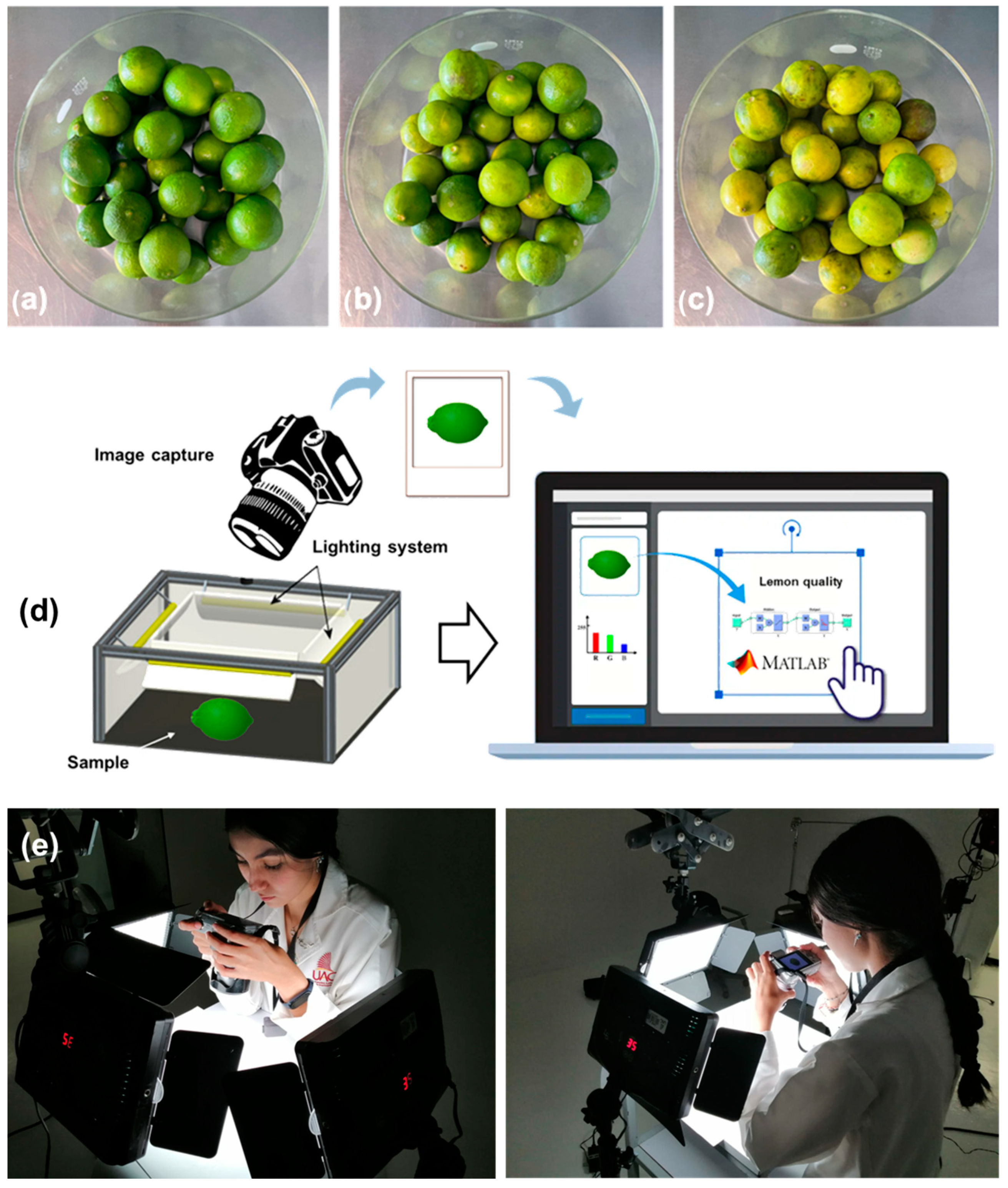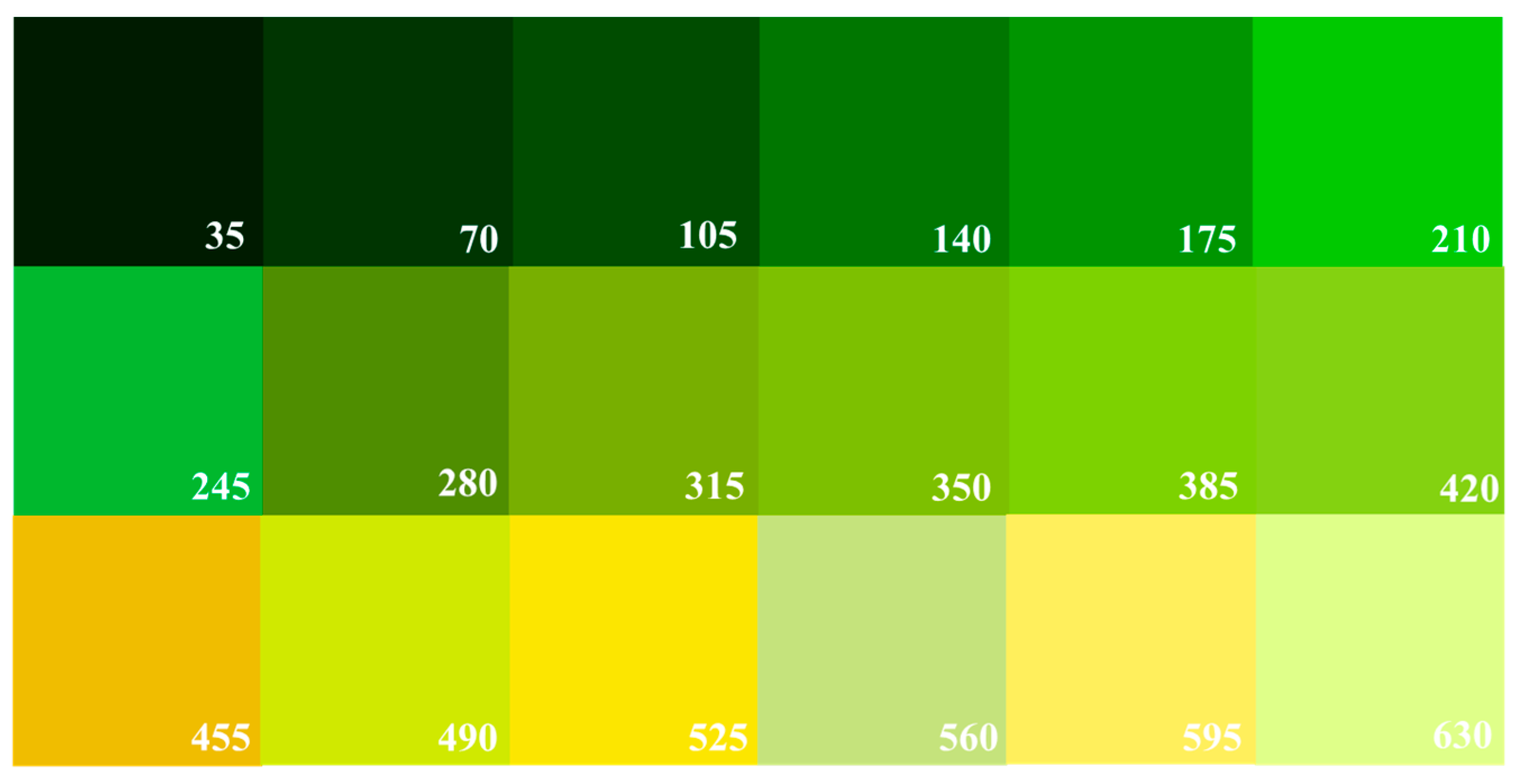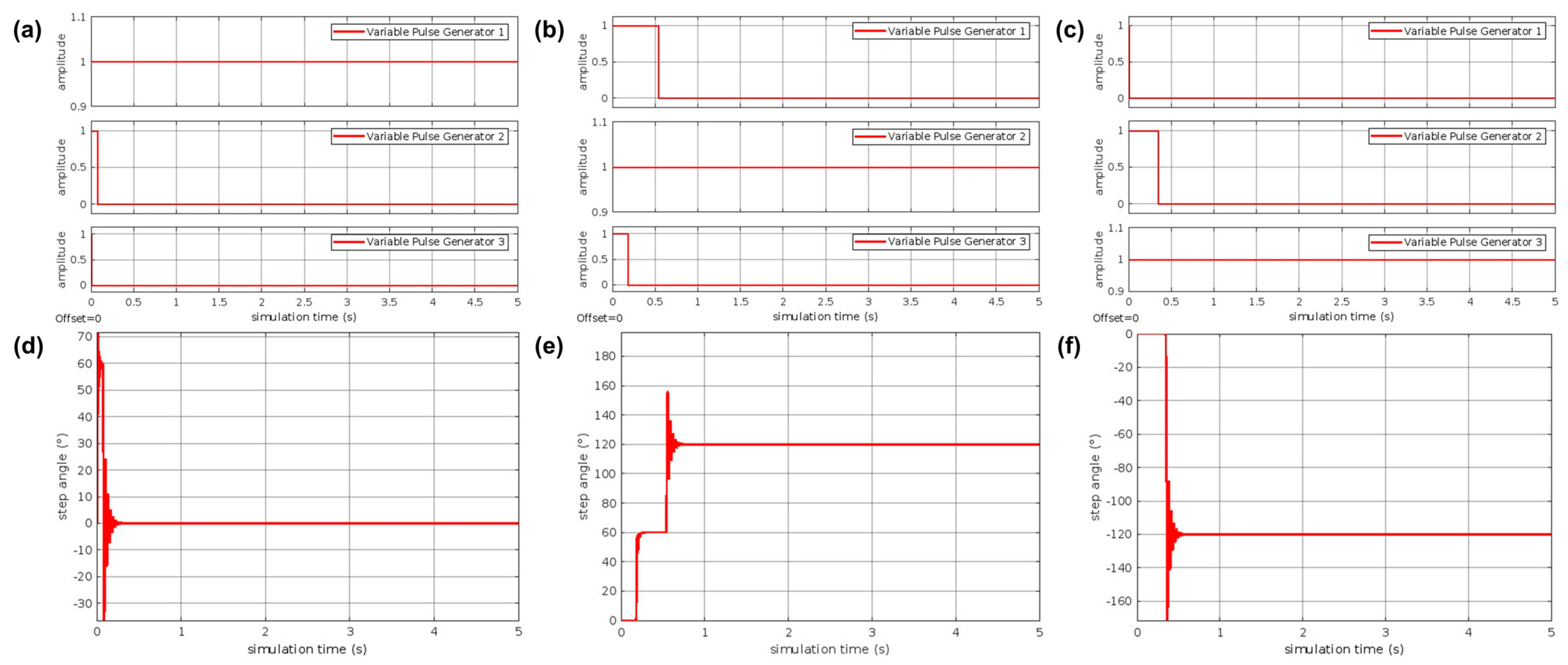Development of a Low-Cost Artificial Vision System as an Alternative for the Automatic Classification of Persian Lemon: Prototype Test Simulation
Abstract
:1. Introduction
2. Materials and Methods
2.1. Samples
2.2. Color Study Using Digital Image Processing
2.3. Physical Properties Analysis in Lemons
2.4. Artificial Neural Network Approach
2.5. MATLAB Simulink Model Prototype
3. Results and Discussion
3.1. Physicochemical Parameters of Persian Lemons: Analysis of Categories
3.2. Construction and Training of the Proposed ANN
3.3. MATLAB Simulink Model Prototype: Test Simulation
4. Conclusions
Supplementary Materials
Author Contributions
Funding
Data Availability Statement
Acknowledgments
Conflicts of Interest
References
- Raddatz-Mota, D.; Franco-Mora, O.; Mendoza-Espinoza, J.A.; Rodríguez-Verástegui, L.L.; Díaz de León-Sánchez, F.; Rivera-Cabrera, F. Effect of Different Rootstocks on Persian Lime (Citrus latifolia T.) Postharvest Quality. Sci. Hortic. 2019, 257, 108716. [Google Scholar] [CrossRef]
- Mukhtar, T.; Jamil, S.; Arif, U.; Razzaq, W.; Wasif, M. Lemon Grading and Sorting Using Computer Vision. Eng. Proc. 2021, 12, 55. [Google Scholar] [CrossRef]
- Nayak, J.; Vakula, K.; Dinesh, P.; Naik, B.; Pelusi, D. Intelligent Food Processing: Journey from Artificial Neural Network to Deep Learning. Comput. Sci. Rev. 2020, 38, 100297. [Google Scholar] [CrossRef]
- Cubeddu, A.; Rauh, C.; Delgado, A. Hybrid Artificial Neural Network for Prediction and Control of Process Variables in Food Extrusion. Innov. Food Sci. Emerg. Technol. 2014, 21, 142–150. [Google Scholar] [CrossRef]
- Batista, L.F.; Marques, C.S.; Pires, A.C.d.S.; Minim, L.A.; Soares, N.d.F.F.; Vidigal, M.C.T.R. Artificial Neural Networks Modeling of Non-Fat Yogurt Texture Properties: Effect of Process Conditions and Food Composition. Food Bioprod. Process. 2021, 126, 164–174. [Google Scholar] [CrossRef]
- Zalpouri, R.; Singh, M.; Kaur, P.; Kaur, A.; Gaikwad, K.K.; Singh, A. Drying Kinetics, Physicochemical and Thermal Analysis of Onion Puree Dried Using a Refractance Window Dryer. Processes 2023, 11, 700. [Google Scholar] [CrossRef]
- da Silva Sauthier, M.C.; da Silva, E.G.P.; da Silva Santos, B.R.; Silva, E.F.R.; da Cruz Caldas, J.; Cavalcante Minho, L.A.; dos Santos, A.M.P.; dos Santos, W.N.L. Screening of Mangifera indica L. Functional Content Using PCA and Neural Networks (ANN). Food Chem. 2019, 273, 115–123. [Google Scholar] [CrossRef]
- Pourdarbani, R.; Sabzi, S.; Hernández-Hernández, M.; Hernández-Hernández, J.L.; Gallardo-Bernal, I.; Herrera-Miranda, I. Non-Destructive Estimation of Total Chlorophyll Content of Apple Fruit Based on Color Feature, Spectral Data and the Most Effective Wavelengths Using Hybrid Artificial Neural Network—Imperialist Competitive Algorithm. Plants 2020, 9, 1547. [Google Scholar] [CrossRef]
- Fan, F.H.; Ma, Q.; Ge, J.; Peng, Q.Y.; Riley, W.W.; Tang, S.Z. Prediction of Texture Characteristics from Extrusion Food Surface Images Using a Computer Vision System and Artificial Neural Networks. J. Food Eng. 2013, 118, 426–433. [Google Scholar] [CrossRef]
- Debska, B.; Guzowska-Swider, B. Application of Artificial Neural Network in Food Classification. Anal. Chim. Acta 2011, 705, 283–291. [Google Scholar] [CrossRef]
- Cimpoiu, C.; Cristea, V.M.; Hosu, A.; Sandru, M.; Seserman, L. Antioxidant Activity Prediction and Classification of Some Teas Using Artificial Neural Networks. Food Chem. 2011, 127, 1323–1328. [Google Scholar] [CrossRef]
- da Silva, C.E.T.; Filardi, V.L.; Pepe, I.M.; Chaves, M.A.; Santos, C.M.S. Classification of Food Vegetable Oils by Fluorimetry and Artificial Neural Networks. Food Control 2015, 47, 86–91. [Google Scholar] [CrossRef]
- Wu, A.; Zhu, J.; Ren, T. Detection of Apple Defect Using Laser-Induced Light Backscattering Imaging and Convolutional Neural Network. Comput. Electr. Eng. 2020, 81, 106454. [Google Scholar] [CrossRef]
- Jahanbakhshi, A.; Momeny, M.; Mahmoudi, M.; Zhang, Y.D. Classification of Sour Lemons Based on Apparent Defects Using Stochastic Pooling Mechanism in Deep Convolutional Neural Networks. Sci. Hortic. 2020, 263, 109133. [Google Scholar] [CrossRef]
- Barré, P.; Herzog, K.; Höfle, R.; Hullin, M.B.; Töpfer, R.; Steinhage, V. Automated Phenotyping of Epicuticular Waxes of Grapevine Berries Using Light Separation and Convolutional Neural Networks. Comput. Electron. Agric. 2019, 156, 263–274. [Google Scholar] [CrossRef]
- Munasingha, L.V.; Gunasinghe, H.N.; Dhanapala, W.W.G.D.S. Identification of Papaya Fruit Diseases Using Deep Learning Approach. In Proceedings of the 4th International Conference on Advances in Computing and Technology (ICACT–2019), Colombo, Sri Lanka, 29 July 2019. [Google Scholar]
- Tran, T.T.; Choi, J.W.; Le, T.T.H.; Kim, J.W. A Comparative Study of Deep CNN in Forecasting and Classifying the Macronutrient Deficiencies on Development of Tomato Plant. Appl. Sci. 2019, 9, 1601. [Google Scholar] [CrossRef]
- Sustika, R.; Subekti, A.; Pardede, H.F.; Suryawati, E.; Mahendra, O.; Yuwana, S. Evaluation of Deep Convolutional Neural Network Architectures for Strawberry Quality Inspection. Int. J. Eng. Technol. 2018, 7, 75–80. [Google Scholar]
- Wang, Z.; Hu, M.; Zhai, G. Application of Deep Learning Architectures for Accurate and Rapid Detection of Internal Mechanical Damage of Blueberry Using Hyperspectral Transmittance Data. Sensors 2018, 18, 1126. [Google Scholar] [CrossRef]
- Zhang, Y.; Lian, J.; Fan, M.; Zheng, Y. Deep Indicator for Fine-Grained Classification of Banana’s Ripening Stages. EURASIP J. Image Video Process 2018, 2018, 46. [Google Scholar] [CrossRef]
- Tan, W.; Zhao, C.; Wu, H. Intelligent Alerting for Fruit-Melon Lesion Image Based on Momentum Deep Learning. Multimed. Tools Appl. 2016, 75, 16741–16761. [Google Scholar] [CrossRef]
- Naranjo-Torres, J.; Mora, M.; Hernández-García, R.; Barrientos, R.J.; Fredes, C.; Valenzuela, A. A Review of Convolutional Neural Network Applied to Fruit Image Processing. Appl. Sci. 2020, 10, 3443. [Google Scholar] [CrossRef]
- Pandey, V.K.; Srivastava, S.; Dash, K.K.; Singh, R.; Mukarram, S.A.; Kovács, B.; Harsányi, E. Machine Learning Algorithms and Fundamentals as Emerging Safety Tools in Preservation of Fruits and Vegetables: A Review. Processes 2023, 11, 1720. [Google Scholar] [CrossRef]
- Zhu, L.; Spachos, P.; Pensini, E.; Plataniotis, K.N. Deep Learning and Machine Vision for Food Processing: A Survey. Curr. Res. Food Sci. 2021, 4, 233–249. [Google Scholar] [CrossRef]
- Zhang, Y.; Deng, L.; Zhu, H.; Wang, W.; Ren, Z.; Zhou, Q.; Lu, S.; Sun, S.; Zhu, Z.; Gorriz, J.M.; et al. Deep Learning in Food Category Recognition. Inf. Fusion 2023, 98, 101859. [Google Scholar] [CrossRef]
- Kakani, V.; Nguyen, V.H.; Kumar, B.P.; Kim, H.; Pasupuleti, V.R. A Critical Review on Computer Vision and Artificial Intelligence in Food Industry. J. Agric. Food Res. 2020, 2, 100033. [Google Scholar] [CrossRef]
- Warren-Vega, W.M.; Contreras-Atrisco, Z.A.; Ramírez-Quezada, M.F.; Romero-Cano, L.A. A Novel Approach of Artificial Intelligence for the Study of the Relation of Physicochemical Profile and Color Acquired by Tequila 100% Agave in Its Maturation Process. J. Food Compos. Anal. 2023, 123, 105533. [Google Scholar] [CrossRef]
- Heil, J.; Marschner, B.; Stumpe, B. Digital Photography as a Tool for Microscale Mapping of Soil Organic Carbon and Iron Oxides. Catena 2020, 193, 104610. [Google Scholar] [CrossRef]
- Rodrigo, M.J.; Alquézar, B.; Alós, E.; Lado, J.; Zacarías, L. Biochemical Bases and Molecular Regulation of Pigmentation in the Peel of Citrus Fruit. Sci. Hortic. 2013, 163, 46–62. [Google Scholar] [CrossRef]
- Tanaka, A.; Tanaka, R. Chlorophyll Metabolism. Curr. Opin. Plant Biol. 2006, 9, 248–255. [Google Scholar] [CrossRef]
- Cho, B.H.; Koseki, S. Determination of Banana Quality Indices during the Ripening Process at Different Temperatures Using Smartphone Images and an Artificial Neural Network. Sci. Hortic. 2021, 288, 110382. [Google Scholar] [CrossRef]
- Mukherjee, A.; Sarkar, T.; Chatterjee, K.; Lahiri, D.; Nag, M.; Rebezov, M.; Shariati, M.A.; Miftakhutdinov, A.; Lorenzo, J.M. Development of Artificial Vision System for Quality Assessment of Oyster Mushrooms. Food Anal. Methods 2022, 15, 1663–1676. [Google Scholar] [CrossRef]
- de Moraes, J.L.; de Oliveira Neto, J.; Badue, C.; Oliveira-Santos, T.; de Souza, A.F. Yolo-Papaya: A Papaya Fruit Disease Detector and Classifier Using CNNs and Convolutional Block Attention Modules. Electronics 2023, 12, 2202. [Google Scholar] [CrossRef]










| Properties | Category “Extra” | Category I | Category II |
|---|---|---|---|
| Hue | 126.83 ± 7.23 | 87.83 ± 25.60 | 60.95 ± 9.08 |
| Saturation | 95.60 ± 7.21 | 87.85 ± 11.07 | 62.44 ± 17.36 |
| Value | 42.39 ± 20.85 | 78.65 ± 12.05 | 91.84 ± 4.88 |
| Color intensity | 127.43 ± 56.62 | 341.2 ± 68.54 | 538.55 ± 57.49 |
| Weight (g) | 26.50 ± 3.00 | 25.69 ± 3.02 | 23.05 ± 3.08 |
| Diameter/Length | 0.92 ± 0.08 | 0.91 ± 0.06 | 0.97 ± 0.07 |
| Thickness (mm) | 1.50 ± 0.29 | 1.48 ± 0.32 | 1.29 ± 0.33 |
| Fruit | Study | Goal | Ref. |
|---|---|---|---|
| Apple | Laser-induced light backscattering imaging and convolutional neural network | Automatic identification and detection of apple defects achieving a recognition rate of 92.5% | [13] |
| Lemon | Stochastic Pooling Mechanism in Deep Convolutional Neural Networks | Detect defects and grade them achieving a recognition rate of 100% | [14] |
| Papaya | CNNs * and Convolutional Block Attention Modules | disease detector with a mean average precision of 86.2% | [33] |
| Tomato | Deep CNN * | nutritional deficiencies detection in the cropping process with a mean average precision of 91% | [17] |
| Strawberry | Deep CNN * | quality classification achieving a recognition rate of 96.49% | [18] |
| Blueberry | CNN *, ResNet *, ResNeXt * | Detection of internal mechanical damage achieving a recognition rate of 89.5% | [19] |
| Banana | CNN * | Fine-grained classification of banana’s ripening stages achieving a recognition rate of 94.4% | [20] |
| Melon | CNN * | Skin lesion achieving an accuracy rate of 98.5% | [21] |
Disclaimer/Publisher’s Note: The statements, opinions and data contained in all publications are solely those of the individual author(s) and contributor(s) and not of MDPI and/or the editor(s). MDPI and/or the editor(s) disclaim responsibility for any injury to people or property resulting from any ideas, methods, instructions or products referred to in the content. |
© 2023 by the authors. Licensee MDPI, Basel, Switzerland. This article is an open access article distributed under the terms and conditions of the Creative Commons Attribution (CC BY) license (https://creativecommons.org/licenses/by/4.0/).
Share and Cite
Granados-Vega, B.V.; Maldonado-Flores, C.; Gómez-Navarro, C.S.; Warren-Vega, W.M.; Campos-Rodríguez, A.; Romero-Cano, L.A. Development of a Low-Cost Artificial Vision System as an Alternative for the Automatic Classification of Persian Lemon: Prototype Test Simulation. Foods 2023, 12, 3829. https://doi.org/10.3390/foods12203829
Granados-Vega BV, Maldonado-Flores C, Gómez-Navarro CS, Warren-Vega WM, Campos-Rodríguez A, Romero-Cano LA. Development of a Low-Cost Artificial Vision System as an Alternative for the Automatic Classification of Persian Lemon: Prototype Test Simulation. Foods. 2023; 12(20):3829. https://doi.org/10.3390/foods12203829
Chicago/Turabian StyleGranados-Vega, Bridget V., Carlos Maldonado-Flores, Camila S. Gómez-Navarro, Walter M. Warren-Vega, Armando Campos-Rodríguez, and Luis A. Romero-Cano. 2023. "Development of a Low-Cost Artificial Vision System as an Alternative for the Automatic Classification of Persian Lemon: Prototype Test Simulation" Foods 12, no. 20: 3829. https://doi.org/10.3390/foods12203829
APA StyleGranados-Vega, B. V., Maldonado-Flores, C., Gómez-Navarro, C. S., Warren-Vega, W. M., Campos-Rodríguez, A., & Romero-Cano, L. A. (2023). Development of a Low-Cost Artificial Vision System as an Alternative for the Automatic Classification of Persian Lemon: Prototype Test Simulation. Foods, 12(20), 3829. https://doi.org/10.3390/foods12203829









